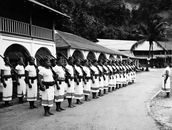TALES OF TIME: The Pan Am Plane Crash of 1974, Pago Pago American Samoa
The 30th of January marks the anniversary of the Pan American Flight 806 crash in Pago Pago during the 70s.
Although decades have passed, family and friends of those who perished still mourn today as a day of grief that took the lives of 97 people onboard the flight.
Pan Am Flight 806 was an international scheduled flight from Auckland, to California, with intermediate stops at Pago Pago, American Samoa and Honolulu. The flight was a popular island hopping and connection flight between the Pacific and the US during the golden years of Pan America simply known as “Pan Am’.

On January 30, 1974, the Boeing 707 Clipper Radiant crashed on approach to Pago Pago International Airport, killing 87 passengers and ten crew members.
Families all over New Zealand, America and Samoa mourned those lost in the crash of a flight that was expected to safely land carrying the loved ones of people waiting in all three countries.
In 1970s, after what was described as a comprehensive investigation the National Transportation Safety Board (NTSB) determined the probable cause of the accident was the flight crew's tardy identification of microburst-induced wind shear. Listed in the report was other possible contributing factors including poor visibility and a lack of altitude and airspeed callouts by the aircrew.
At 23:11, Flight 806 contacted Pago Pago Approach Control and reported its position 160 miles south of the Pago Pago airport.

The next 20 minutes of the radio conversation between the flight crew and the controller was recorded. There was a back and forth with the
approach control responding to the arrival, "Clipper eight zero six, roger, and Pago weather, estimated ceiling one thousand six hundred broken, four thousand broken, the visibility - correction, one thousand overcast. The visibility one zero, light rain shower, temperature seven eight, wind three five zero degrees, one five, and altimeter's two nine eight five."
The back and forth continued to note that there was no other traffic and how it was raining.

On the flight deck the windshield wipers were turned on and the flaps were set at the 50° position, which completed the checklists for landing. At 23:40:22, the first officer stated, "You're a little high." The radio altimeter warning tone then sounded twice.\
He reported the field in sight and said that they were at 140 kts. At 23:40, the aircraft crashed into trees at an elevation of 113 feet, and about 3,865 feet short of the runway threshold.
The first impact with the ground was about 236 feet farther along the crash path. The aircraft continued through the jungle vegetation, struck a 3-foot-high lava rock wall, and stopped about 3,090 feet from the runway threshold.
Although the flight crash report includes the transcription of the last conversation between the flight crew and the Pago Pago operators, many families still hold unanswered questions on what happened. The most common questions is “How could a trained staff on a large corporate airline flight fail to carry out their due diligence?”.

Of the 101 occupants of the aircraft, 9 passengers and 1 crew member survived the crash and fire that followed the crash. One passenger passed the next day. A crew member and three passengers passed 3 days after the accident. The last causality of the flight passed away 9 days following due to injuries brought on by the crash.

The Pan Am 806 will mark its 50th anniversary in 2 years. 5 decades later generations of the families impacted still mourn what could’ve been and the tragedy of this dark day.
Family members such as Sopo Su’a who lost her grandmother Telinga Tangatauli on the flight. Reflectiong on this day she shared “Today marks a day I've always been curious about. My nana Telinga Tangatauli died on the Pan Am Aeroplane crash 30th Jan 1974 in American Samoa. One story mum shared was that nana took off her wedding ring and offered to give it to my mum and mum said no that's you and dads wedding ring. My granddad was waiting for her to arrive in Samoa. Sadly, she never arrived”.
Sopo joins family and friends of the victims of the Pam Am 806 crash all remembering their loved ones today.
-
Written by Brianna Fruean
Public Interest Journalism funded by NZ On Air



